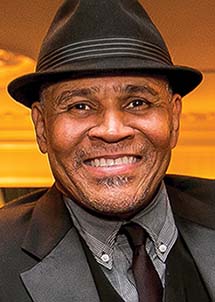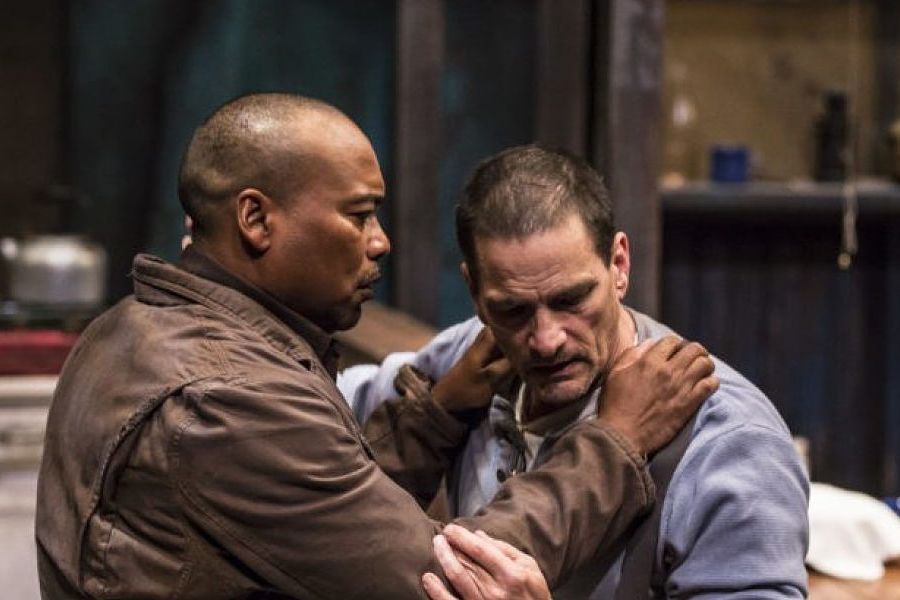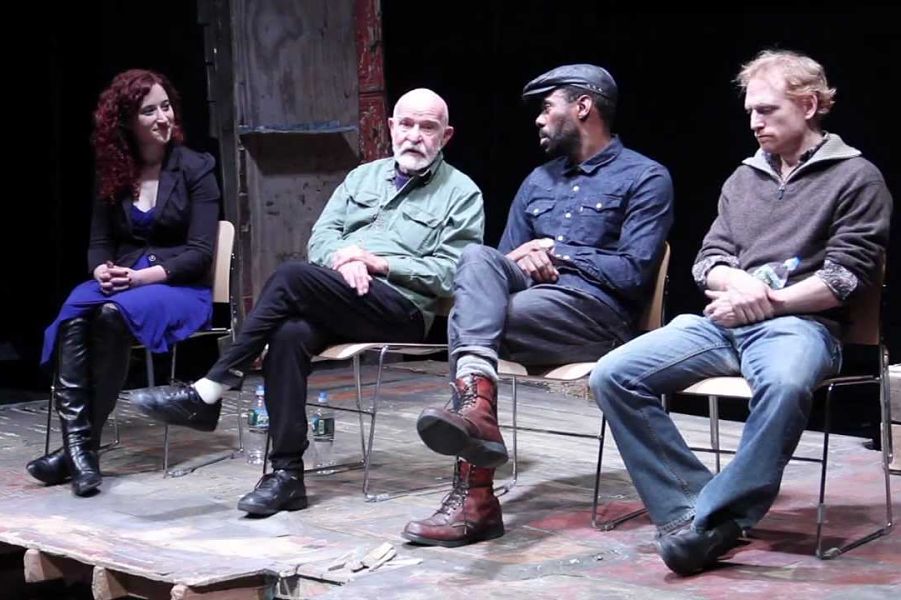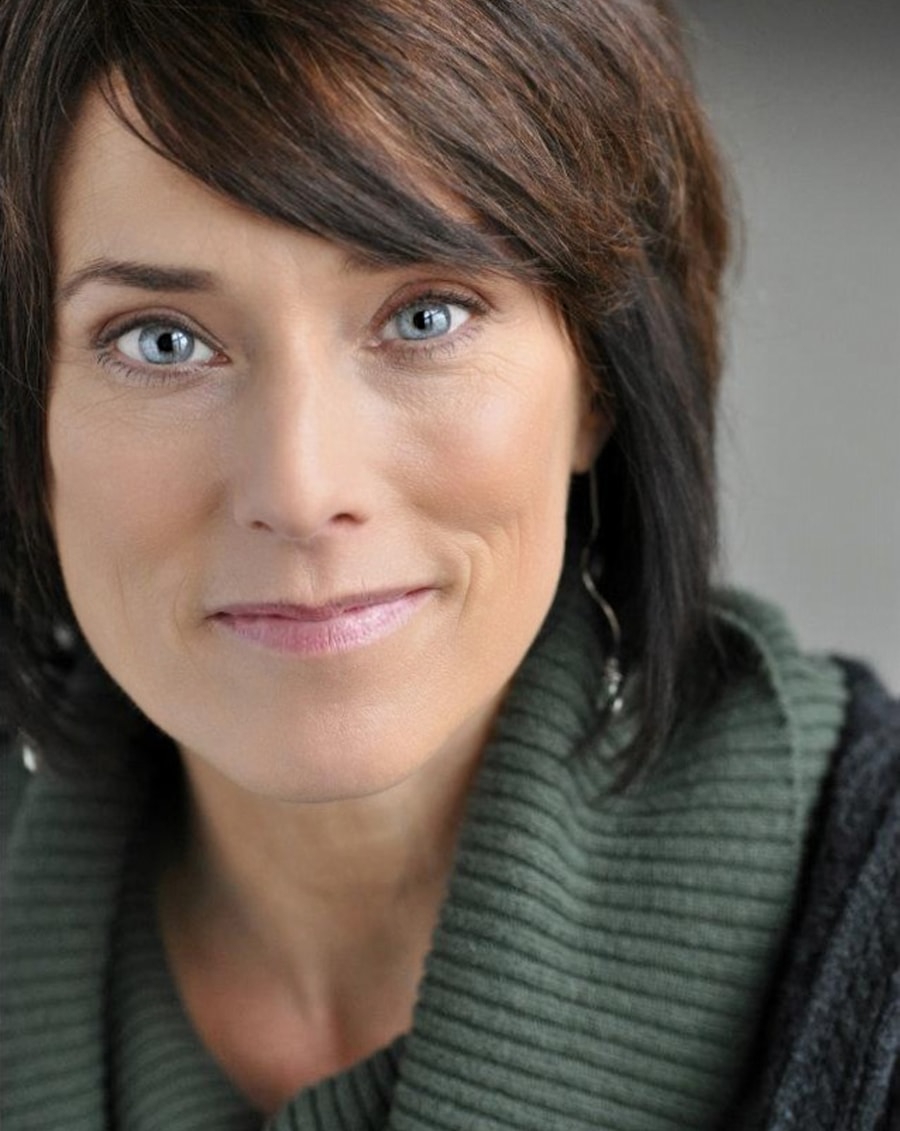MORRIS: You’re horrible.
ZACHARIAH: Sorry, Baas.
MORRIS: You stink.
ZACHARIAH: Please, my Baasie…
MORRIS: What did you mean crawling around like that? Spoiling the view, spoiling my chances! What’s your game, hey? Trying to be an embarrassment? Is that it? A two-legged, bloody embarrassment? Well, we’ll see about that. I hate you, do you hear? Hate!…Hate!…Hate!
He attacks Zachariah savagely with the umbrella.
So goes one of the climactic moments of Athol Fugard’s 1961 play Blood Knot. It’s enough to make anyone shift uncomfortably, no matter who is onstage.
But who’s onstage is exactly what’s causing discomfort and controversy around the current production of Blood Knot at Spring Green, Wisc.’s American Players Theatre. In those moments, Morris (played by Jim DeVita) berates Zachariah (played by Gavin Lawrence), a light-skinned man expressing overt racial hatred toward his dark-skinned counterpart. The problem is that the play says these men are brothers, children of the same black mother, one who can “pass” as white, the other who can’t.
Controversy first emerged around this production when Mike Fischer, in a long review in the Milwaukee Journal Sentinel on June 18, questioned the theatre’s choice to cast a white man as the light-skinned, ostensibly mixed-race Morris. Building on the energy of the previous weekend’s protest and walkout at the Muny in St. Louis over its production of Jerome Robbins’ Broadway’s casting a white woman in the role of an Asian character, a petition was posted by Michael Barker, managing director of Westport Country Playhouse, urging “theatre leaders across the country to reexamine their casting practices and policies in an attempt to avoid similar situations in the future.” Original signatories included managing directors from Milwaukee Repertory Theater, Actors Theatre of Louisville, and Portland Center Stage, among others.
The petition and outrage surrounding APT’s Blood Knot, and APT’s subsequent statements defending their casting, have since sparked a debate about what role metaphor, playwrights’ intention, and history can (or should) play in these complicated decisions.

Ron OJ Parson, the director of APT’s production, makes sense of the choice by pointing to the show’s final scene. In it the two brothers play a game in which Morris dresses up as a white man and role-plays interactions that the dark-skinned Zachariah has at work every day. These interactions are filled with intense racism and hatred.
“I wanted what we ended up with,” said Parson, “which is a white guy saying those hateful things and then representing all the hate that’s in the world. For me, the payoff of that one time when he uses ‘n’ word in that scene—the payoff is more relevant if it is a white guy.”
Of course, the complications of the optics are obvious: a white man berating a black man onstage and using the “n” word, all while calling that black man his brother and claiming a shared heritage. That’s a lot of dissonance for an audience to handle. For Gavin Lawrence, who plays Zachariah in the production, that dissonance is precisely the point: This challenging sight forces an audience to engage in a way they wouldn’t if they could simply look at the play as a domestic drama between two black brothers.
“After having done quite a few performances now, I’m more convinced than ever that the way we cast is the way that it’s supposed to be cast,” Lawrence said. “I find that when my white brother turns that privilege back on me to empower himself, what happens in the audience is way more powerful. One brother getting so caught up in that privilege that he has the courage because of the way he looks—not because of what he is, but when he undoubtedly looks white, when he was called ‘white man’—not a light-skinned man, not a mulatto, not an African, not, ‘Oh, he can sort of pass, he must have some black in him somewhere.’ A white man onstage. The audience has to see themselves reflected in that. They are forced to. At that moment, we are all culpable in this thing that is called race, and race relations, and racism.”

Much of the defense coming from the APT creative team takes this view: that the metaphor of privilege and race in Fugard’s play, so crucial to the play’s effect, influences how the play should be cast. They believe that the audience should see the character just as others would see a white-passing black man: as simply a white man.
“He was out there totally passing, and witnessing the hate,” Parson said. “There was no doubt that he was white, so they were themselves, so to speak, around him. Let’s just think about what he has experienced out there in that world, being able to be looked upon from black and white as a white person.”
But it’s exactly that double experience that makes casting a white person in this role irresponsible, according to Madison, Wisc.-based actor and director Dana Pellebon. She acknowledges that the hatred depicted by the play is real, but that the hatred is also real between actual light-skinned black people and their dark-skinned brothers. In her view their stories, already so underrepresented onstage, should be able to be told by those who have the lived experience. In her eyes, having a white man play the role of Morris, though he “looks” white, is still a form of blackface.
“We have progressed on variety of different levels,” Pellebon said, “including knowing that taking and co-opting somebody’s cultural experience as a white person is wrong.”

The experience Pellebon is pointing to is one of colorism, or skin-color bias. To put it simply, colorism highlights the differences in the lived experience between those with light skin versus those with dark, both among African Americans and within other communities, including the Latinx community. In an essay from Teaching Tolerance, teacher David Knight discussed seeing color-conscious conversations between students reflecting unconscious and unspoken biases toward those with lighter skin.
“This topic, of the ability to pass, is something that is raw and real with my community,” Pellebon explained. “To have a white man portraying that struggle is a slap in the face for people in my family who had to make those choices because there were no other choices. It was how they were able to get jobs. It was how they were able to come out of extreme racism and discrimination in the South. That is a choice that we have had to make because it has been untenable for black people to be able to live in this world as black people.”
Of course the world that Fugard puts onstage, and from which the play emerged, is not the American South but the South African apartheid system of the 1950s and ’60s. When Fugard first produced Blood Knot, for a single performance in 1961, he played the role of Morris. It was a bold, even illegal move at the time, as Fugard was working with a multiracial group of actors at a time when the South African state was working to keep the races separate. As Fugard explained in a letter to APT, during apartheid “racial classification was extremely arbitrary and often rested on nothing more than the racial prejudices of the classification board and what they regarded as ‘other.’ I have always seen Blood Knot as an extended metaphor, which the use of a white actor serves to exaggerate.”

While in that letter he said he wasn’t opposed to the idea of casting a mixed-race actor as Morris, when Fugard himself directed a revival at New York City’s Signature Theatre in 2012, he cast a white actor, Scott Shepherd, in the role. Making no mention of the racial optics of the casting in his otherwise mixed review, The New York Times’ Charles Isherwood wrote that the play “brings to life the thankfully distant brutalities of apartheid with the piercing humanity that distinguishes all his finest work.” He continued to point out that, while the play is naturalistically set, “Mr. Fugard was clearly writing under the influence of Samuel Beckett.”
A lot has changed in six years. Now, despite any metaphorical intention or Beckettian absurdity, Pellebon and others are calling for those in charge of casting to be more conscious of representation onstage. Some critics note that in the case of APT’s production, the decision to cast Jim DeVita as Morris was made by Brenda DeVita, APT’s artistic director and the actor’s wife, prior to Parson joining the production. While this is not uncommon in the few regional theatres that have core companies of actors (APT is one, the Oregon Shakespeare Festival is another), the timeline of this process muddies the waters, said Kelvin Dinkins Jr., chair of the League of Resident Theatres’ Equity, Diversity, and Inclusion committee.
“I feel like with this particular play the casting is so nuanced that there can’t be just a unilateral ‘this is wrong’ stamp placed on it,” Dinkins said. “But there are so many conversations that go into it that.”
He doesn’t want to dictate artistic choices to artists, he said, but when a strong, potentially controversial choice is made—such as casting a white man in a role that a light-skinned black man could have potentially played—the procedural reasoning should be in place to back the decision up.
“My comfort would be in the director saying, ‘I saw the best actor for the part,’” Dinkins said. “If he said, ‘I saw 100 auditions and this actor brought the best narrative to the stage in his audition.’ You know what? Then I’d say, ‘Okay, I wasn’t there. I don’t know.’ And if the play’s good, the play’s good, and they’ve done it. But I know for a fact that the director [here] cannot say that, and that’s my inherent issue with the casting controversy, as it were. He wasn’t afforded that privilege of making that decision. It was made for him.”

Brenda DeVita responded that as APT worked through the planning process for Blood Knot, she spoke with a few different directors about their vision for the show, and that these conversations touched on casting. Having been to the theatre a few times and seen Jim DeVita onstage, Parson agreed that the actor would fit his vision of the play, especially considering the last scene.
“I backed the decision,” Parson said. “I’m all for it, because it’s what I wanted to do with the play. People are responding to something because of the climate of the world today. What’s going on politically in this country is causing us to band together and not take it anymore. I think that’s good, because you need to get political. I understand it—but again, from an artistic point, people need to look at the big picture.”
For his part, Dinkins pointed to a big picture very much worth keeping in view: A 2017 Actors’ Equity Association diversity study showing that from 2013 to 2015, around 66 percent of principal contracts for Broadway and touring plays and musicals went to white performers, while less than 11 percent went to African Americans, and under 2 percent went to Asian Americans. Dinkins feels that the entire industry could stand to be more transparent about its casting choices and more conscious of their implications.
Nearby Wisconsin company Milwaukee Rep has formed an ED&I task force to try to change these statistics, according to a statement provided by managing director Chad Bauman. The advising group consists of artists outside of the company, staff within the company, and diversity experts from the region.
“In doing so, we wanted a diverse advisory group of people who were not entirely beholden to the company for employment so they could be forthright and honest with their assessments of our work,” Bauman said in the statement.
Investing in ED&I is an essential component of the power given casting directors, directors, and artistic directors, Dinkins said. When looking at reactions from theatres over the years in reacting to controversies, Dinkins said he’s not interested in after-the-fact apologies, or in companies saying it was never their intent to hurt whatever underserved population has stood up and spoken out. If the issue only arises after someone stands up, that’s a problem in itself.

“I think this issue is so much bigger than one show’s casting decision,” Dinkins said. “It’s systemic. And if we’re not going to challenge these systems, then we’re sort of wasting our breath. If an intern at your theatre can’t walk into the artistic director’s office and discuss a casting choice like this, and have it be an open and inviting conversation, then I think you have a problem.”
Brenda DeVita said that APT encourages such dialogue, and that she has an open-door policy that invites company members “to tell us how we can do our jobs better.” This includes conversations with core company members to discuss the season in advance, where they can ask DeVita to explain her choices. DeVita said she also spoke with other producers during the decision-making process, and that in the case of Blood Knot, the core company had discussed the process, the play, and what they believed the audience would take away from it.
“My philosophy has always been, absolutely, ask those hard questions, absolutely engage in those conversations,” said DeVita. “I’ve met with everybody about this, because this is their theatre. They’ve trusted my work here to create an environment that is owned by people who work here. So our work with all the actors, all the artisans, our production staff, is all about the feedback.”
DeVita said that her conversations about the play started years ago, and that in fact the company anticipated some controversy about the casting. Blood Knot is the third Fugard play APT has produced, after their 2010 production of Exits and Entrances and their 2015 production of The Island. Those early discussions included Lawrence, with whom they had long wanted to work. He said that APT was very thorough in its decision-making around the play. That’s why, though he had other options he could have pursued, he signed on to do Blood Knot.
“I’m on the front lines when it comes to appropriation and all that, but this is not that,” Lawrence said. “And I would not want to do the play in any other way. That’s a waste of my time and energy. Emotionally, every night doing this play, it’s not worth it if we’re just trivial.”
In an effort to continue the conversation and open it up to a wider audience, APT is adding a “pay what you’d like” performance of Blood Knot on Sunday, Aug. 12, at noon (tickets will be on sale online starting on or around July 13). Following the performance will be a panel discussion to explore the issues in the play, including the casting. Panelists for that performance have not yet been announced.
This may be the opportunity for those like Pellebon, who looks to hold the artistic decision-makers responsible for how they are promoting diversity, to have their voices heard by APT. Pellebon acknowledged that APT is making an effort to diversify its work. But for her, APT’s role as a highly respected organization that people want to work with means that they also need to use their place to allow underrepresented groups to tell their own stories.
“It is not the responsibility of the persons in privilege to tell those stories,” Pellebon said. “The responsibility of the persons in privilege is to elevate other people to be able to tell their own stories. It is important that we use our privilege—and all of us have privilege in one way or another—it is important that we use our privilege to elevate those that do not. That’s true equity and justice.”
Jerald Raymond Pierce is a writer based in Chicago.


